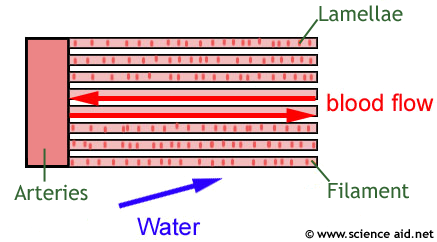Gas Exchange
Edited by Jamie (ScienceAid Editor)
Surface Area: Volume Ratio
The rate of diffusion in an organism is dependent upon the surface area (this is the flat area covering the organism).
The problem is that generally an organism's volume increases at a much greater rate than the surface area does. Therefore a huge organisms like a whale has a lot of volume gas needs to supply, but not enough area to let it in. In comparison, a bacterium that is very small has a surface area : volume ratio some 1.000.000.000 (one thousand million / billion) times bigger.
This presents a problem for the whale: he cannot survive on oxygen diffused through the skin so alternative mechanisms must evolve (in reality it was the other way round: the evolution of complex respiratory systems allowed larger animals to develop). Also this small surface area : volume ratio means that like gas heat cannot escape from the whale very quickly either. So more heat is retained.
If the organism wishes to exchange a lot of substances with its surroundings, it must adapt, and this is where gas exchange comes in:
Gas Exchange in Fish
For more information about gas exchange in plants and mammals see Transpiration and the Lungs
Getting oxygen for respiration is very difficult for the fish because there is very little dissolved oxygen in water compared to in air. So it has a specialised system to ensure efficiency.
Above is a gill. It is made of filaments which the blood supply travels along. And these are covered in feathery lamellae; which are only a few cells thick and contain capillaries. The filaments and lamellae serve to increase the surface area.
Water is drawn in through the Buccal Cavity (mouth) of the fish. This is then forced through over the gills and out of the opercular valve. The key to this system is that the blood flows in the opposite direction to the water. So the blood and water are both travelling towards each other. This is called the counter-current system.
This system is very important because it increases and maintains the concentration gradient; so the maximum amount of dissolved oxygen can be extracted from the water.
Referencing this Article
If you need to reference this article in your work, you can copy-paste the following depending on your required format:
APA (American Psychological Association)
Gas Exchange. (2017). In ScienceAid. Retrieved Apr 26, 2024, from https://scienceaid.net/biology/cell/gasexchange.html
MLA (Modern Language Association) "Gas Exchange." ScienceAid, scienceaid.net/biology/cell/gasexchange.html Accessed 26 Apr 2024.
Chicago / Turabian ScienceAid.net. "Gas Exchange." Accessed Apr 26, 2024. https://scienceaid.net/biology/cell/gasexchange.html.
If you have problems with any of the steps in this article, please ask a question for more help, or post in the comments section below.
Comments
Article Info
Categories : Cell




